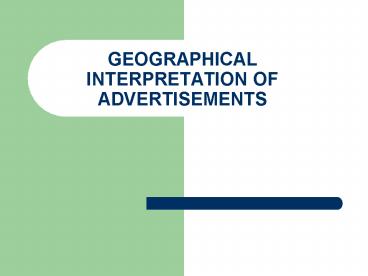GEOGRAPHICAL INTERPRETATION OF ADVERTISEMENTS - PowerPoint PPT Presentation
1 / 38
Title:
GEOGRAPHICAL INTERPRETATION OF ADVERTISEMENTS
Description:
geographical interpretation of advertisements – PowerPoint PPT presentation
Number of Views:36
Avg rating:3.0/5.0
Title: GEOGRAPHICAL INTERPRETATION OF ADVERTISEMENTS
1
GEOGRAPHICAL INTERPRETATION OF ADVERTISEMENTS
2
Why is place so important in ads?
- Many ads use a special setting to promote the
product - This is very rarely the most likely setting in
which to use the product - Wild, natural environments are popular
3
(No Transcript)
4
(No Transcript)
5
(No Transcript)
6
(No Transcript)
7
What are the functions of place in ads?
- Forms a link between the product and its user
- This link says something about the personal
identity of the user his/her hopes, dreams,
aspirations, values, etc.
8
Learn to read places in ads
- What does it tell the consumer about
himself/herself? - If the place is hard to get to, what does that
say about being there? - Why show the product being used in a remote and
wild place? - What message is carried by the place itself and
what message is carried by access to that place? - Can you read the intersections between social
class and access to place?
9
(No Transcript)
10
(No Transcript)
11
(No Transcript)
12
(No Transcript)
13
Ads and conflicting ideals
- People generally seek status in society
- People also generally dream of dropping out or
escaping from society - Ads provide images that reconcile these
conflicting desires
14
What product is associated with this place?
15
(No Transcript)
16
(No Transcript)
17
What is going on here?
- How is the consumer supposed to see
himself/herself? - What qualities of place are being evoked here?
- How does the product carry those qualities of
place to the consumer? - What is the user supposed to desire and how
effective is the product in delivering that? - What stands between the consumer and what he/she
desires? - There is another invisible place the place of
consumption. How does it fit in?
18
(No Transcript)
19
(No Transcript)
20
(No Transcript)
21
(No Transcript)
22
Generic place
- A place that could be many different places
- The seashore
- The city
- The desert
- The mountains
- The jungle
- Etc.
- Generic places are quite often gendered
23
What gender is the desert?
24
Dont think men arent insecure
25
What aspects of the desert reinforce cultural
stereotypes of masculinity?
26
Environment as challenge
- Many ads that show natural settings present the
environment as a challenge - Men, in particular, are supposed to want to test
themselves against this challenge - Men are also supposed to believe that any kind of
technological assistance in meeting this
challenge is OK and does not invalidate the idea
that nature tests (and therefore shows off) their
manhood
27
What kind of place is gendered feminine?
- Earth Goddess
- Luxuriant vegetation
- Green growing
- Soft
- Luminous
- Not dry
- City Princess
- Luxurious
- Sleek
- Sophisticated
28
A fantasy-place stands in for what other kinds of
fantasy?
29
(No Transcript)
30
(No Transcript)
31
Other identity stereotypes in generic places
- The desert represents a masculine fantasy of
toughness, ruggedness, and (dare we say it)
hardness - Both the garden and the city represent feminine
fantasies of romance, seduction and sensual
pleasure - What about fantasy places for children?
32
(No Transcript)
33
Whats the impact of this?
- Ads intervene in place symbolism
- Place symbolism guides action
- So ads ultimately affect action
- (this must be true or advertisers would not pay
for them) - All human actions in some way affect large-scale
systems of geographical interest - Bottom line is increased consumption and
increased alteration of natural systems resource
depletion, habitat loss, pollution and climatic
alteration
34
The upshot of all this is
- Consumption
- Ads sometimes work to deny this fact, creating
other place images
35
(No Transcript)
36
Summary
37
Ads do various things
- Promote diffusion (thats their purpose, put in
our vocabulary) - Use and reinforce certain generic place images
- The beach
- The big city
- The wilderness
- The small town
- The farm
- Etc.
- Use and reinforce stereotypes about men, women
and children - Q. What about racial and ethnic stereotypes in
ads? How do they use place?
38
What does an ad do?
- Ad creates links
- Between a place or landscape and a product
- Between a place or landscape and a particular
identity (e.g. a tough and independent cowboy, a
sleek and sophisticated urbanite, etc.) - Ad makers intend for these associations to linger
in the background (unconscious) because people
buy the product in order to take on the
particular identity but the product cant fulfill
its implicit promise - Ad promotes and denies the act of consumption
- People are compelled to buy more and more
products to satisfy their insecurities - This leads to a resource-intensive lifestyle with
heavy environmental impacts that the producers
would rather disregard or else actively deny































